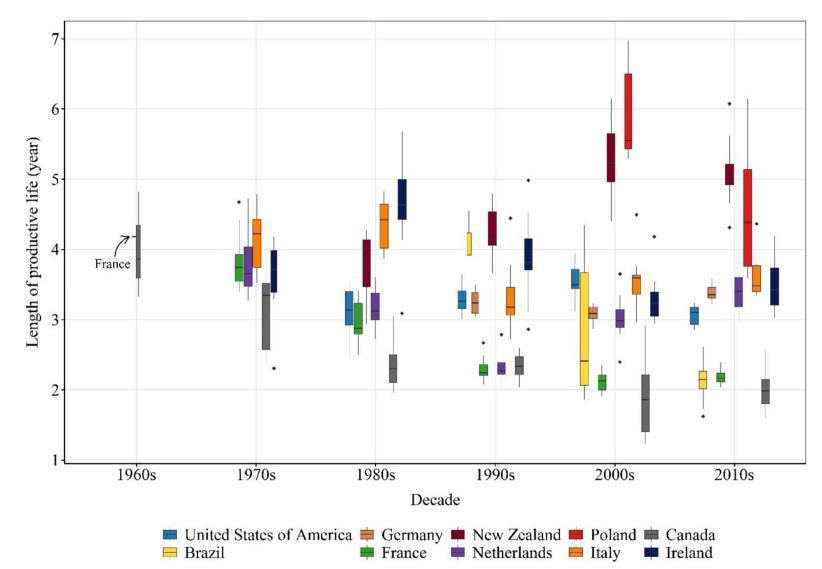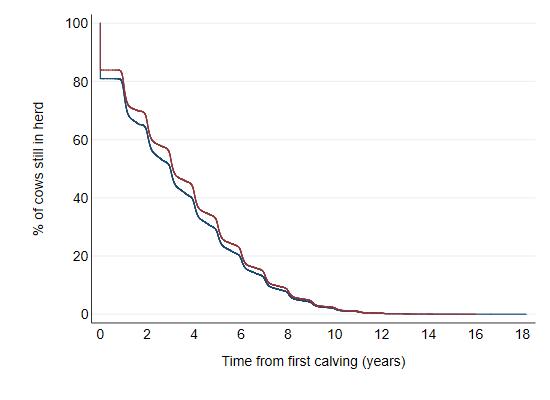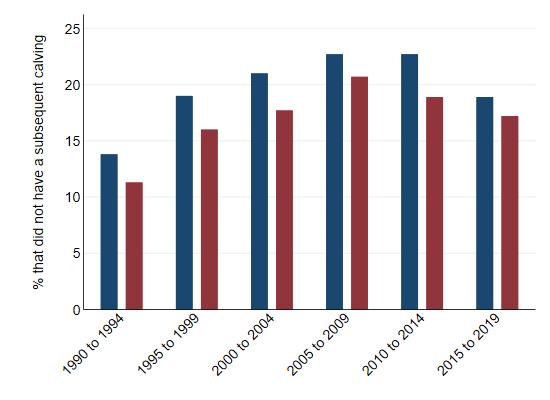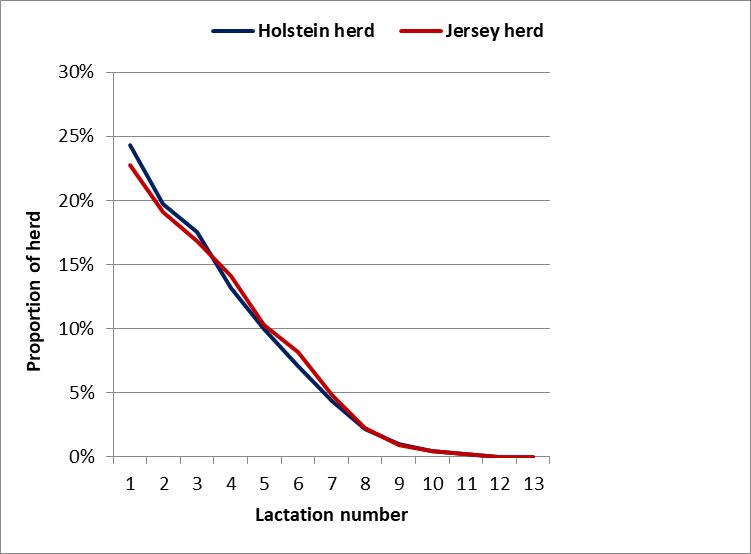
6 minute read
7. Longevity
Key points: Cow longevity (survival) in a herd has an important influence on the herd’s production efficiency, profitability and environmental footprint Jerseys tend to live longer, producing longer, and survive to later lactations more frequent than Holsteins in single and mixed breed herds Increased longevity in a herd means the herd’s mean milk production is higher and fewer nonproductive replacement heifers are required
When respondents to the Jersey Australia survey were asked to give their level of agreement with the statement ‘Jerseys remain productive for longer in the herd than other breeds’: 66% agreed or strongly agreed, 19% disagreed or strongly disagreed, and 15% were unsure.
Advertisement
The length of a cow’s productive life is determined by many inherent cow factors such as milk yield, health, reproductive status, and reproductive performance, and external factors such as milk price, salvage value, cost and availability of replacements. Ultimately, it is the farmer’s culling strategy that determines how long a cow remains in the herd. Many different definitions and methods of measuring longevity have therefore been developed. These include age at last calving, number of lactations, length of life between first calving and culling, age at culling or removal, and survival to different ages [Van Doormaal et al., 1985]. In their review, Schuster et al. (2020) recommended using the following terminology: Herd life (HL) - days from birth until culling Length of productive life (LPL) - days from first calving until culling Stayability or Survivability - the proportion of cows that survive to a specific age
In dairy production, cow longevity (survival) in a herd has an important influence on the herd’s production efficiency, profitability and environmental footprint. Cows reach full maturity and produce the most milk in their fifth lactation [Grandl et al., 2016]. With increased longevity in a herd, there is a greater proportion of mature cows in the herd and the herd’s mean milk production is therefore higher. With increased longevity, a lower herd replacement rate is required, and therefore fewer non-productive replacement heifers are required, as illustrated in Table 8. [DeVries et al., 2020].
Table 8. Number of replacement heifers a farm needs to rear per year (300 cow herd with 20% heifer non-completion rate) [Little, 2021].
The length of productive life (years) of dairy cows differs between milk-producing countries, and this may be associated with the different production systems used, and the culling criteria applied in each production system in each country (Figure 18). Reproductive failure and health problems around calving are the most frequent reason for involuntary culling worldwide [DeVries et al., 2020; Dallago et al., 2021].
Sensitivity Analysis:
Adult Cow Cull Rate
72 22% 24% 26% 28% 30% 22 73 79 86 92 99
Age 24 79 86 94 101 108
First 26 86 94 101 109 117 Calving 28 92 101 109 118 126 30 99 108 117 126 135
Figure 18. The length of productive life (years) of dairy cows from the top 10 high milk-producing countries by decade. The relative width of each box per country within decades represents the number of observations available to generate it. The wider the box, the more observations were available [Dallago et al., 2021].
Many of the Jersey breed organisations report that Jersey cows have the highest rate of staying in production and the lowest rate of removal. For example, USJersey (2016) presented the annual National Dairy Herd Improvement Association Reports for 2015 and showed that the proportion of Jerseys continuing in production was 72.3%, whereas for all other breeds and crossbreds, the proportion was 66.9%. Differences in reproductive performance, lower incidence of mastitis, less disease and injury, and fewer feet and leg problems were identified as contributing to the lower rate of removal in Jerseys. However, the difference between Jerseys and the other breeds had been reduced from about 5.4% units to only 3.5% units by 2019 [Council on Dairy Cattle Breeding, 2020].
There have been relatively few reports in the scientific literature that have compared the longevity of Jerseys against that in Holsteins, particularly within herd. In a very early study, Parker et al. (1960) analysed the disposal records of Jersey and Holstein cows from USDA herds at Beltsville, Maryland, and their results indicated that, although 41% of the Holsteins and 21% of the Jerseys were removed from the herds as non-breeders, differences in longevity between individual cows were determined largely by non-genetic influences.
In their analyses across different herds in USA, Garcia-Peniche et al. (2006) found that the Jersey breed showed an advantage above Holstein cows for all the longevity-related traits studied. The survival of Holsteins to 5 years of age was lower than for Jerseys, both in herds with single breeds and when the two breeds were compared within herds. The Jerseys’ greater longevity was attributed to younger ages at first calving and shorter calving intervals. Unfortunately there have been very few of these types of comparative studies where Jerseys and Holsteins are kept in the same herd under similar conditions.
In a more recent US study based on 5.9 million DHIA lactation records from 10 Midwest states from 2006 to 2010, Shahid et al. (2015) found that Holstein cows had a significantly higher mortality hazard than Jersey, Ayrshire, Brown Swiss, and crossbreds. Jerseys had a 21% lower mortality hazard ratio than Holsteins. However, a Danish study found that Jerseys had a greater mortality incidence risk than Holsteins (Maia et al., 2013).
Analysis of Australian herd calving data from 1980 to mid-2020 held by DataGene shows that of the Jerseys enrolled at their first calving (100%), 84% went on to further calvings and so 16% had no further calvings in that herd. In contrast, for Holsteins, 81% went on to further calvings and so 19% had no further calvings. Up to 8 years from first calving, the percentages of cows still in the herd were slightly higher for Jerseys (Figure 19).
Figure 19. Percentages of cows still in herd by time from first calving for Jerseys (maroon; n=394,443 cows) and Holsteins (navy; n=2,366,820 cows), 1990 to 2020; cows first calved in any year included [DataGene, 2021].
These patterns were also assessed separately for cows first calved in 1990 to 1994, 1995 to 1999, 2000 to 2004, 2005 to 2009, 2010 to 2014, and 2015 to 2019. (Figure 20). In all these periods, the percentages of first calvers (aged 21 to 30 months at first calving) that had no further calvings was lower for Jerseys than Holsteins. For both Jerseys and Holsteins, percentages of first calvers that had no further calvings increased progressively from the period 1990 to 1994 to the period 2005 to 2009 before declining. (See Appendix H for further information).
Figure 20. Percentages of first calvers (aged 21 to 30 months at first calving) that did not have a subsequent calving in the herd for Jersey (maroon) and Holstein (navy) cows by year of first calving [DataGene, 2021].


These differences in the longevity of Jerseys and Holsteins impact on the herd replacement rate required to maintain a herd and the milking herd’s cow age profiles, with Jersey herds having slightly fewer younger (lower producing) cows and more (higher producing) older cows (Figure 21).

Figure 21. Jersey and Holstein milking herd profiles, across seasonal, split and year-round-calving systems, based on 25,703 and 138,792 calving records respectively for 2019 [DataGene, 2021].









